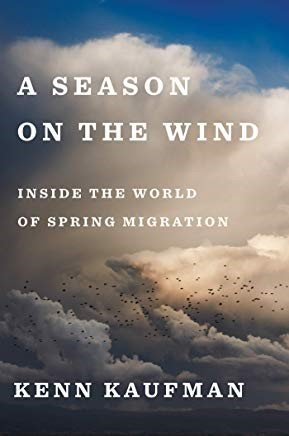
How blessed can one guy be?
Not only is Kenn Kaufman a world-class birder and all-around naturalist who makes his living doing what he loves. Not only has he authored multiple field guides, and prose works, too (such as the classic coming-of-age-as-a-birder story, Kingbird Highway).
But best of all — the thing that shows, surely, that he was born under a lucky star, is this: he’s now (as of 2005, when he migrated, permanently, to Ohio) — a Buckeye.
A Season on the Wind: Inside the World of Spring Migration is Kaufmann’s latest book, being published just in time for the North American northward migration in April and May – that time when, he says, “the migrants from the tropics have arrived in a rush, creating that glorious sense of diversity and abundance, the sense that anything is possible in the perfection of springtime.”
More than 5,000 bird species in the world make some kind of seasonal movement. On our North American continent, tens of millions of birds are flying northward on peak spring nights. In Kaufman’s telling, all of them, all of those flights, seem like millions of miracles.
He gives lots of marvelous examples, such as the Blackpoll warbler, “among the most astonishing and extreme of all migratory birds.”
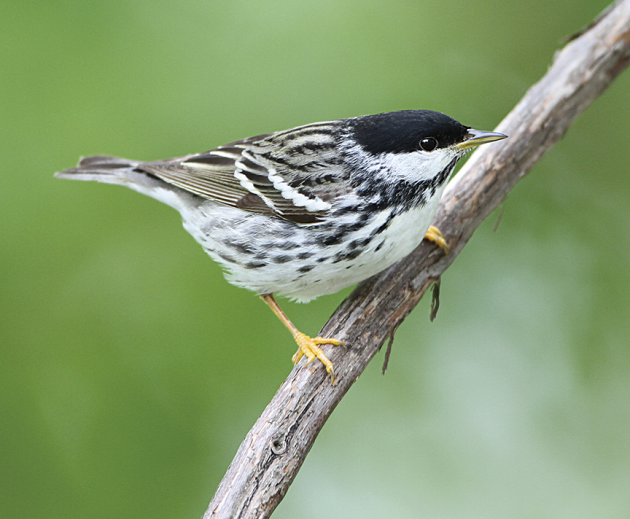
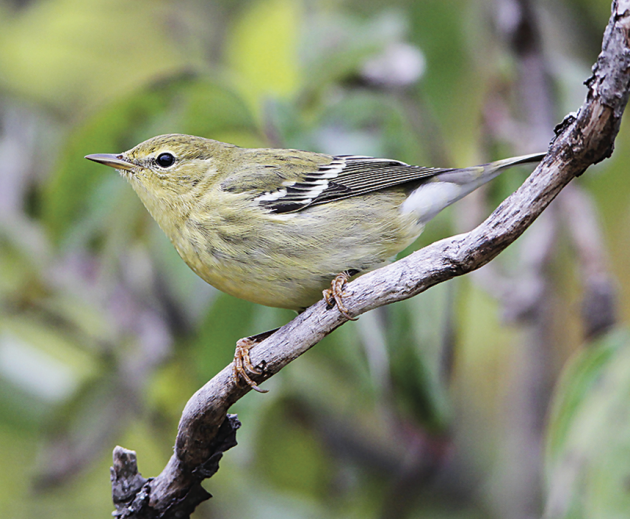
In the spring (when they look like they do — the males, that is — in the photo on the left, above) they fly more than six thousand miles from the Amazon Basin to the Arctic, via Florida and Ohio. But in the fall (with plumage as in the photo on the left, above) they take an entirely different, and heroic, route, first to Massachusetts and then, after a rest, south over the Atlantic Ocean. The blackpoll, “a bird with a body just a little larger than your thumb,” doesn’t stop until South America. As Kaufman says: “Four nights and three days in the air. Eighty hours of flying. More than two thousand miles. Hundreds of thousands of beats of its small wings . . . . As a test of endurance, as a physical ordeal, it’s both miraculous and monstrous.”
Other birds are the subjects of Kaufman’s wonder, too, such as the early ducks — pintails, green-winged teal, and various diving ducks. “The sense of motion and raw energy is irresistible,” he says.
And dunlins (below), masters of synchronized flying, “convey the full rush of the season, the unstoppable drive that will take them on to the Arctic.”
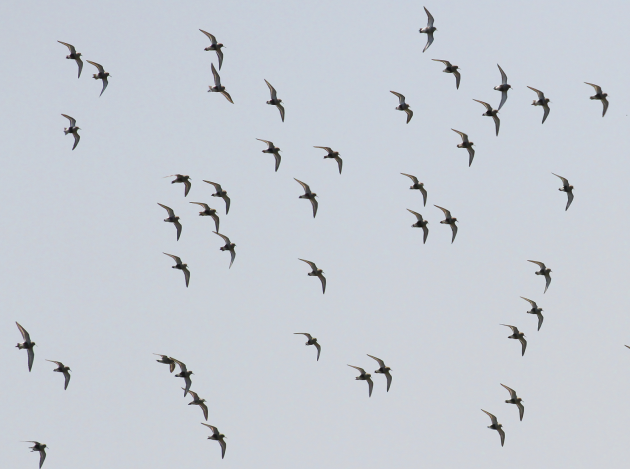
So, yes, there’s plenty enough information about migration in the book to justify the subtitle. But the other subject of A Season on the Wind is Kaufman’s adopted state – or, more precisely, one corner of it, the one that includes the Black Swamp Bird Observatory (“BSBO”) and Magee Marsh Wildlife Area, just west of Toledo. (Kaufman’s wife, Kimberly Kaufman, is the BSBO’s Executive Director.)
Magee Marsh, and its legendary boardwalk (below), have become renowned in recent years for the great multitude of migratory birds that stop there for R&R, and food, before continuing north across Lake Erie. “The Biggest Week in American Birding” is held there, a place its organizers call “The Warbler Capital of the World,” in the first week of May.
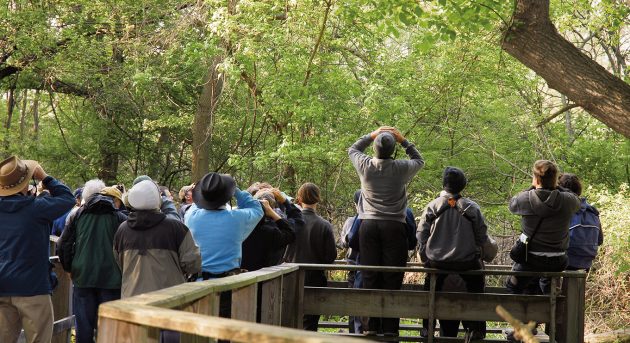
The harshest law of all, one more draconian than any human legislature could enact, is the law of unintended consequences. Example A, perfectly up to date, is the wind turbine. They have been touted as a means to clean, renewable energy, a way to leave fossil fuels behind. As Kaufman shows, however, to birds and bats, they can be death machines.
Wind turbines have been proposed several times for areas close to the BSBO – one of the great bird flyways on the continent — and the Kaufmans (and their colleagues) have spent a great deal of time and energy campaigning against them.
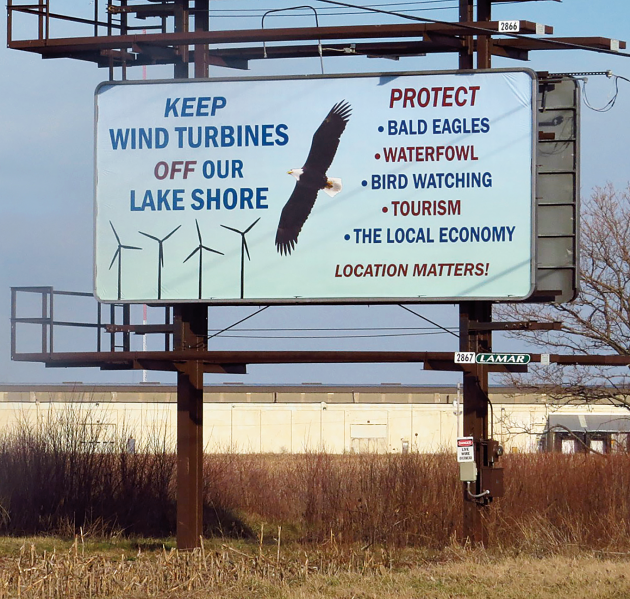
It is, in Kaufman’s telling, plodding and often frustrating work, but absolutely necessary: his descriptions of the malign effects of wind turbines can make for painful reading. (Eastern red bats, for only one example, may actually be attracted to wind turbines; and unlike birds, they are often killed by “barotrauma” – their inner organs explode from the drop in air pressure as the blade sweeps past.)
“Environmental groups are all over the map regarding their positions on wind energy,” Kaufman says, and “the forces pushing hardest for wind-power development don’t speak any language but money.”
(One other irony in this regard is this: there is some evidence that migrating birds are benefited by the “rest stops” offered by oil rigs in the Gulf of Mexico, according to another good book on migration, Miyoko Chu’s 2006 Songbird Journeys. In other words, a symbol of the old, dirty energy technology (the oil rig) is a boon for birds, while a symbol of the brave new world of clean energy, (the “windmill”) is deadly.)
Kaufman is attuned to these sorts of ironies, ones that sometimes arise from supposedly competing interests. As he points out, his beloved Magee Marsh would never have been preserved, or saved from development, had it not been home, at one time, to a duck-hunting club, which later transferred the land to the state of Ohio. Kaufman knows that duck hunters can be ardent, loving conservationists, too.
Kaufman is a terrific writer and A Season on the Wind is a terrific book. What comes through most of all from the prose is Kaufman’s unending reverence and awe and delight in the natural world: “Everything, everything, becomes more astounding the more we look at it.”
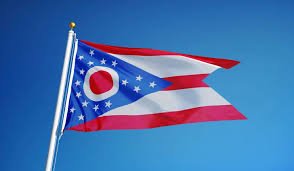
A Season on the Wind: Inside the World of Spring Migration
by Kenn Kaufman
Houghtton Mifflin Harcourt (April 2, 2019)
288 pp., 5 1/2 X 8 1/4, $26
ISBN-978-1-328-56642-3











Very spirited and evocative review. Thank you!